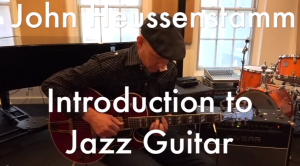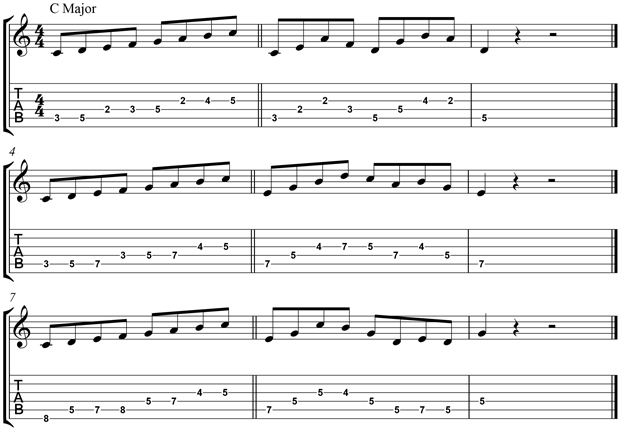LessonFace with John Heussenstamm: Introduction to Jazz Guitar

This video and article offer introductory jazz guitar concepts from guitarist and music educator John Heussenstamm. Author and co-author of multiple widely distributed books and videos from major music education publishers, and recipient of more than 10 million views on YouTube, Heussenstamm now can be reached for live online lessons via Lessonface.
How many pianos are there in the world? Millions, right?
They all have the same keyboard layout of the C major or A minor scale on the white keys.
It must be important or such an instrument wouldn't exist. The jazz guitarist should focus on that and make a thorough study of the C major diatonic scale in all of its positions and discover its significance.
In my experience as a teacher, usually the up-and-coming player neglects this area because they feel it's boring and doesn't sound like the wild jazz they're so anxious to hear coming out of their instrument.
Since a large part of all the music in the world is based on this sound, every aspect of melody and harmony you learn from your diatonic study can be applied to the more dissonant and outside-the-box sounds. The scales that are more difficult to command are easier to use once you master the more fundamental harmonies.
In the three examples below, I've given a different fingering and position for each one with a corresponding melody. The reason it's a good idea to learn more than one position or fingering is because of our physical limitations.
Melodies that are too difficult to play in one area might be possible or easier to play in another. My desire as a teacher is not to show what to play but how to go about playing what YOU could play if you were familiar with different positions. MAKE UP YOUR OWN MELODIES ONCE YOU KNOW WHERE THE NOTES ARE! Octaves are a popular sound for the jazz guitar. One should listen to Wes Montgomery and George Benson. Study their use of octaves and hear how it really highlights their style and sound. The next line is an exercise I use to help familiarize students with the sound and technique required to play octaves. Octaves based on the E and A strings are two frets apart. Octaves based on the D and G string are three frets apart. The theory of the line is going up in 4ths. A 4th is the interval between all the notes climbing in the music line. Example A B C D = 1 2 3 4. 1 to 4 would be called a 4th. To play octaves on the guitar we have to mute or deaden the strings our fingers aren't pressing. To do that lightly touch the string next to the one you're pressing by leaning into it with that finger. We can also pinch or pluck the octave strings with the thumb and fingers of the right hand. It really helps to have a teacher show you this. The use of octaves is simply based on fattening or beefing up the sound of each note in a melody. In the following example, I wrote a simple blues melody with bass notes. I then added the higher octave note. We can do this with any melody, but really super-fast jazz lines are difficult or perhaps impossible to play with octaves. There might be someone like Scotty Anderson who can do it. Unlike the trumpet or saxophone, that can only play one note at a time, the guitar can play intervals and chords with more than one note sustained and sounded out simultaneously. Some of my favorite sounds in all of music are jazz chords on the guitar. I particularly like the use of the thumb and fingers of the right hand plucking the strings. You can get piano and harp-like results from a relatively small instrument. George Van Eps used to call his guitar a lap piano. * Notice that all the voicings of the next example consist of four notes designed to be played by the thumb, first, second and third fingers of the right hand. All the theories to develop these kind of results are found in blues and jazz. As I said before and so often do, study music theory and harmony from the perspective that a keyboard offers then organize and label everything that universal way. Then go about breaking all the rules or making up your own rules to come up with your own sound. But first learn the fundamentals! Having several chords cascading down is a wonderful effect in music. Most of the chords in this upper example relate directly to the key of C. Whenever there is a flat or sharp used you could say you've left the key or you're hearing accidentals. To get smooth transitions back and forth or in and out of keys is a main feature in jazz and it is the responsibility of the jazz musician to learn how to resolve his or her musical ideas smoothly and gracefully. This final example of jazz guitar in this brief lesson touches upon chord melody; having chords and melody notes being played at the same time. You can accompany your own melodies with chords as a soloist. This gives you the ability to work on your own in different venues and events without the need of any other musician backing you up; a triumph for the little guitar man. The sample melody harmonized.






John Heussenstamm offers live online lessons and classes on Lessonface.com. Learn more.
Get The Pick Newsletter
All the latest guitar news, interviews, lessons, reviews, deals and more, direct to your inbox!
“There are so many sounds to be discovered when you get away from using a pick”: Jared James Nichols shows you how to add “snap, crackle and pop” to your playing with banjo rolls and string snaps
Don't let chord inversions bamboozle you. It's simply the case of shuffling the notes around







![Joe Bonamassa [left] wears a deep blue suit and polka-dotted shirt and plays his green refin Strat; the late Irish blues legend Rory Gallagher [right] screams and inflicts some punishment on his heavily worn number one Stratocaster.](https://cdn.mos.cms.futurecdn.net/cw28h7UBcTVfTLs7p7eiLe.jpg)


